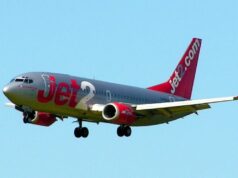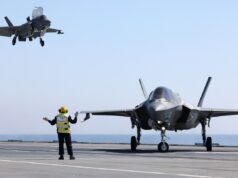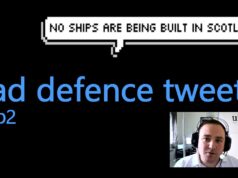F-18 Super Hornets from the USS George H.W. Bush have performed a flypast of HMS Queen Elizabeth.
The USS George H.W. Bush has UK personnel on board as part of the UK-US Long Lead Specialist Skills Programme which the Royal Navy say qualifies them in US carrier operations in preparation for the arrival of HMS Queen Elizabeth.
Exercise Saxon Warrior will take place between the 1st and 10th of August and will be delivered by the Joint Tactical Exercise Planning Staff from Faslane.
Commodore Andrew Benton, Commander UK Carrier Strike Group said:
“Exercise Saxon Warrior is a large, multinational joint exercise which involves fifteen warships from five different nations, submarines, over 100 aircraft and about 9,000 personnel,” said Cdre Betton.
The UK contribution will be two Type 23 frigates supporting the US aircraft carrier, a Royal Navy submarine, the Carrier Strike Group UK battle staff, fixed wing and rotary wing aircraft operating from ashore, and then the central training staff who will based in Faslane in Scotland.”
Colonel Phil Kelly, Royal Marines is the COMUKCSG Strike Commander said:
“This exercise is a great demonstration of the UK’s relationship with the United States who are helping us in getting back our carrier strike capability and making a success of the Queen Elizabeth aircraft carrier programme.”
According to the Royal Navy, the Type 23 frigates taking part in Saxon Warrior will be HMS Iron Duke and HMS Westminster who will be joined by Royal Fleet Auxiliary fast fleet tanker Wave Ruler.
As we reported in January, Saxon Warrior is an exercise designed to develop ‘theatre-specific combat skills’ as well as enhance cooperation between multi-national forces.
Led by Flag Officer Sea Training (FOST), Saxon Warrior presents a ‘myriad of challenges to the multi-national and multi-platform force by creating a diverse and unpredictable war environment based on fictional geo-political and military scenarios’.
Cmdr Eric Retz, US Navy Carrier Strike Group 2’s operations officer, said of the exercise:
“Saxon Warrior will test every aspect of our war-fighting capabilities-from air wing strikes to the self-defenxe of the carrier.
The beauty of operating with coalition partners is that we practice with them, learn their strengths, and then blend those strengths together to make the most potent coalition force possible.”
Trials are simultaneously underway for both HMS Queen Elizabeth and F-35B Lightning before they come together in 2018 but just what do sea trials involve?
Sea trials monitor speed, manoeuvrability, power and propulsion as well as undertaking weapons trials and additional tests on her levels of readiness.
Sea trials were planned beginning in March 2017 but minor technical issues delayed her sea trials until the end of June. Prior to the ship’s departure from Rosyth, an extensive survey was carried out of the Firth of Forth by HMS Gleaner and 42 Regiment, Royal Engineers to gather information on the tides, the depth of the river bed, and the height of the three river crossings (Forth Bridge, Forth Road Bridge, Queensferry Crossing).
Queen Elizabeth sailed on the 26th of June 2017. The first stage of the operation was to move the ship from inside the fitting out basin, via one of the access gates, into the Firth of Forth itself, before taking the ship under the three Forth bridge crossings.
Once this was accomplished, the ship took to the open sea off the east coast of Scotland to undertake the first set of trials, including handling and speed tests. During this period, Queen Elizabeth was accompanied by a pair of Type 23 frigates, HMS Sutherland and HMS Iron Duke, acting as escorts.
The first aircraft to land on the ship was a Merlin HM.2 of 820 Naval Air Squadron on the 3rd July. Following initial runs in and around the Firth of Forth, the carrier was taken further north to the Moray Firth, during which period the ship encountered the Cunard cruise liner Queen Elizabeth.
HMS Queen Elizabeth had her first stopover at Invergordon, where the ship was fuelled and provisioned, and where inspections of the hull were carried out.







